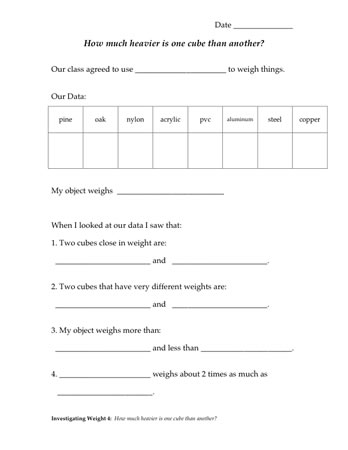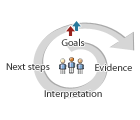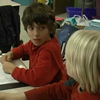How much heavier is one cube than another?
Plan Investigating Weight 4
Paper clips … washers … counting bears … choose one!
Formative Assessment
Available online at inquiryproject.terc.edu
Students weigh the cubes as well as their personal objects with everyone using the same standard unit of measurement. They record the weights (in number of paper clips, washers, or plastic bears) in a class table and place the cubes on a weight line. Students now have the data they need to address the investigation question: How much heavier is one cube than another? They also have an opportunity to compare two representations of the data—the table and the weight line—and to reflect on what each representation has to offer.
By the end of the investigation, students will start to quantify the difference in the weights of the cubes. They will also begin to appreciate the continuous nature of the weight line.
Learning Goals
- to measure and compare weights using a single measure
- to understand that there can be many different weights between any two weights
| Sequence of experiences | ||
|---|---|---|
| 1. Ask the question | All Class | 5 Mins |
| 2. Weigh the cubes | Small Groups | 15 Mins |
| 3. Make meaning | All Class | 15 Mins |
| 4. Make everyday connections | Small Groups | 10 Mins |
Materials and Preparation
For the class:- Post the investigation question in a place where all students can see it.
- Post the class data table for recording the weights of the cubes; an example is shown in Step 2.
- Place the class weight line with its index card label in an easily accessible place, preferably where it can remain for a while for reference.
- 180 bears or 250 metal washers or 600 jumbo paper clips
- 2 sets of cubes
- 1 index card labeled with the chosen unit of measure
- 2 pan balances
- 4 personal objects
Concept Cartoon

The Weight Concept Cartoon is typically used as a formative assessment at the end of this investigation.
Notebook Pages
Do students understand that there are many weight values (possible weights) between any two numbers, for example, between 3 and 4?
By listening to their discussion, you can find evidence of students' understanding of what their measurement readings do and don't tell them. In the following classroom, students have found that one cube was heavier than another but measured in bears, their weights are the same (2 bears).
As she interprets students' ideas, Jen listens for the idea that a cube is unlikely to weigh exactly a whole number of bears. One cube may weigh between 2 and 3 bears but closer to 2, and another cube between 1 and 2 bears but closer to 2. Thus the two cubes weigh the same number of whole bears and yet one cube actually weighs a little more than the other.
As a next step, the teacher in this class encouraged students to suggest other explanations.
1. Ask the question
Recall the difficulty students had last session, when they tried to weigh the cubes using a mixture of paper clips, steel washers, and counting bears.
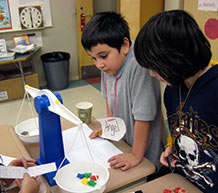
- What did we decide to do this time?
- We decided to use just one measure, but which one was it?
Once the class has agreed what the class measure is (paper clip, washer, or bear), introduce the investigation question:
- How should we go about answering this question?
Let the students brainstorm some ideas. There will be talk about reweighing, comparing, “counting the difference,” and subtracting. Some students may suggest making a list or compiling a table or using a weight line. Entertain all such ideas, and help the class reach agreement that the task must begin with weighing all the cubes.
2. Weigh the cubes
Distribute two or three cubes (one metal and one non-metal) to each small group such that all 16 cubes will be weighed. At the same time, have the students retrieve their personal objects for weighing.
Ask a member of each group to bring one of their cubes and take enough washers (or bears or paper clips) to weigh the cube. The students can use “felt weight” to estimate how many units they will need.
| Object | Weight in Paper Clips | Weight in Washers | Weight in Bears | Weight in Grams (g) |
|---|---|---|---|---|
| Pine | 6 | 3 | 2 | 8 |
| Oak | 9 | 4-5 | 3-4 | 12 |
| Nylon | 14 | 7 | 4-5 | 18 |
| Acrylic | 14-15 | 7-8 | 5 | 19 |
| PVC | 17 | 8-9 | 5-6 | 22 |
| Aluminum | 34 | 17 | 11 | 44 |
| Steel | 98 | 49 | 32 | 128 |
| Copper | 112 | 56 | 37 | 146 |
| Paper Clip | 1 | 1.3 | ||
| Metal Washer | 1 | 2.6 | ||
| Bear | 1 | 4 |
Note: The pan balances will not give perfectly consistent results but if they have been adjusted for accuracy, differences between measurements should be less than one steel washer.
Students weigh each cube twice, putting a different student in charge each time. They record both weights in their notebooks, then agree on a final weight to record in the class data table. How they reconcile any differences in the measurements is up to them; perhaps they will weigh the cube a third time, or perhaps they will take an intermediate value, or perhaps they will consult with another group. When the table is complete, have students record the weights of all the cubes in their notebooks.
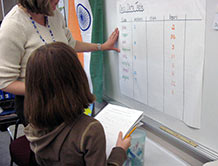
As time permits, children can weigh their personal objects and record those weights in their notebooks for comparison with the weights of the cubes.
| Cube | Weight |
|---|---|
| Pine | |
| Copper | |
| Oak | |
| etc. |
3. Make meaning
Purpose of the discussion
The purpose of this discuss is to consolidate learning from this investigation.
Gather students together and show them the plastic weight line. Explain that the numbers on the weight line refer to the number of measuring units that the class decided on, i.e., steel washers, or paper clips, or counting bears. Place an index card adjacent to the line labeled with the chosen unit of measure. Then invite each team to place its cubes in the appropriate place on the line.
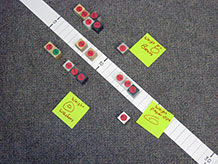
Check students‘ understanding of the visual array by asking a few questions that they can answer by observation. For example,
Note: This is the first time students will use the weight line. Are they familiar with how it is used? You may want to ask a volunteer to place the first cube on the line while others watch. Point out the weight of that cube in the table and then ask the student to find the same number on the line.
- How many cubes weigh less than 50 paper clips?
- Which two cubes are closest in weight?
Looking at both the data table and the weight line, can students find the same cube in both representations? Ask several volunteers to locate different cubes both in the table and on the line.
Engage students in the focus question
Our investigation question is:
How much heavier is one cube than another?
To answer this question,
What did we do?
- used uniform units of weight to weigh the cubes
Why did we do it?
- we couldn’t compare weights when the units were different so we agreed to use [paper clips, washers, bears] to weigh the cubes
What did we find out?
- refer to the cubes placed on the weight line
How much heavier than the pine cube is the PVC cube?
Which cube is about twice the weight of the PVC cube?
How does each of these representations — the data table and the weight line — help you to answer these questions?
What advantages do you see with each representation?
Refer students to the page in their notebooks, and ask them to answer the four questions.
4. Make everyday connections

Invite students to add their personal objects to the weight line.
Consider the results. Are some personal objects too heavy for the line to accommodate? Can students estimate where those objects might be placed? Between which two cubes do most of the personal objects fall? Are there gaps, i.e., places where we find very few personal objects or none at all? Ask,
- If each of you had another object to add to the line, and each of those objects weighed less than the copper cube, would there be a place on the weight line for each of those objects?
If students say “no,” ask for specific examples.
- If you have an object that weighs less than the copper cube, what could it weigh so that there would be no place for it on the line?
Wrap up the strand by asking a couple of open-ended questions about the nature of weight.
- What is the smallest amount of weight you can imagine an object having?
- Could two objects be so close in weight that we could not measure the difference?
- Where does the weight line end?
- What is weight, anyway?


